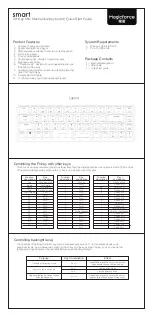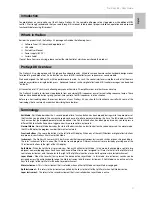
NORD ELECTRO 2 V2.0x
9. History: The story behind the Electro 2 instruments
Page 49
T
T
T
T
H
H
H
HE
E
E
E
E
E
E
E
L
L
L
LE
E
E
EC
C
C
CT
T
T
TR
R
R
RO
O
O
O
2
2
2
2
O
O
O
OR
R
R
RG
G
G
GA
A
A
AN
N
N
N
S
S
S
SE
E
E
EC
C
C
CT
T
T
TIIIIO
O
O
ON
N
N
N
The organ chosen for the task to be simulated was a
Hammond A-100. Except for its cabinet and the inclu-
sion of a built-in sound system, the A-100 works the
same as Hammond's almighty rock 'n' roll organ, the
famous B-3. The Hammond organ was originally de-
signed to be an alternative for churches instead of large
acoustic pipe organs. In the '30s, there was a growing
demand for more compact organs that sounded similar
to pipe organs because small churches couldn't afford
or didn't have the space to install a big pipe organ. The
Hammond organ was designed with drawbars for
sculpting the harmonic content of the organ sound.
They function much like stops on a pipe organ. This
was the standard, and so it became (see figure to the
bottom right of this page).
T
T
T
T
H
H
H
HE
E
E
E
H
H
H
H
A
A
A
AM
M
M
MM
M
M
MO
O
O
ON
N
N
ND
D
D
D
O
O
O
O
R
R
R
RG
G
G
GA
A
A
AN
N
N
N
C
C
C
C
O
O
O
OM
M
M
MP
P
P
PA
A
A
AN
N
N
NY
Y
Y
Y
S
S
S
ST
T
T
TO
O
O
OR
R
R
RY
Y
Y
Y
Has any other keyboard instrument created as much in-
terest as the Hammond organ? The model emulated by
the Nord Electro 2 is the B-3, the most popular version
of all Hammonds produced. Between their release in
1954 and 1974 when they went out of production,
nearly 275,000 B-3 and C-3 organs were built. (The C-
3 is identical to the B-3 except for its cabinet design;
Hammond didn't keep separate records for the two
models.) No other electric keyboard in the world has
exceeded that number -- so far.
It started in the early 1930s, when inventor Lau-
rens Hammond was looking for different applica-
tions for a 60-cycle motor he had designed for his
clock factory. An earlier inventor named Thaddeus
Cahill had, at the beginning of the 20th century,
made an electromechanical instrument called the
Telharmonium, which later caught the attention
of Hammond. Although he wasn't a musician,
Hammond was attracted by the idea to build a
genuine electric musical instrument. Hammond
had a degree in mechanical engineering and had
developed great skill in mechanical design. In his
lab, Hammond and his assistants designed and
built an electromechanical organ based on Cahill's
principles. The basic components of the organ
were tone wheels and electromagnetic pick-ups,
and the instrument is acknowledged as being of ex-
cellent mechanical design for its time.
This is the Hammond A-100 organ that is simulated
by the Nord Electro 2. The A-100 is electrically sim-
ilar to the B-3 and C-3 organs, but it features a dif-
ferent cabinet and has a built-in amplifier, speakers,
and spring reverb. This particular unit left the factory
on June 2, 1965. The A-100 was taken out of pro-
duction four months later.
















































